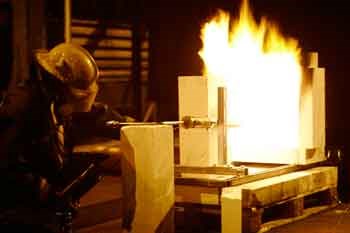Jet fires represent a major fire risk in installations with pressurized hydrocarbons. Jet fires may vary with respect to flame length, heat flux and velocities, and important influencing factors are the type and nature of the fuel, pressure and amount of fuel, geometry of the rupture, and surrounding conditions. The geometry of the structure may also be an important parameter with respect to the resistance of the passive fire protection exposed to a jet fire.
We have a long experience in jet fire testing and has been involved in the development of several jet fire test standards used by the industry and the authorities today.
We can offer single tests or test series comprising of one or several jet fires, as well as jet fires in combination with varying heat flux levels, for example fires following the HC curve. Jet fires can be conducted with heat flux up to 350-400 kW/m².
We offer the following jet fire tests and related tests:
Standard jet fire
The objective of a standard jet fire test is to determine the resistance to jet fires of passive fire protection materials and systems. It gives an indication of how passive fire protection materials behave in a jet fire. The test methods ISO 22899-1 and OTI 95634 both cover:
- Tubulars
- Panels
- Structural steel
- Pipe- and cable penetrations
Extended jet fires
Our extended jet fire furnaces can be used where standard jet fires are unsufficient:
- higher temperatures (1300 – 1400 °C)
- higher heat fluxes (350 kW/m²)
- for larger test specimens (Ø ~1 m)
HC - Jet combination test series
Used for certification for different specifications, with the possibility to interpolate between tests. This gives the possibility to perform variations in the fire protection in multiple test specimens in a single horizontal furnace HC-test, and then compare this to a selection of variations subjected to a jet fire test.
- HC fire (pool fire), horizontal furnace
- Jet fire
- Jet fire addition
Sequential jet and pool-fire test
The extended jet fire furnace can be used to simulate the exposure in a HC fire furnace. This gives us the ability to perform a combination of both jet fire directly followed by a simulated HC-fire in the same test. For example:
- 350 kW/m² jet fire for 15 minutes + 2 hours pool fire.
Pressurized pipes, valves and end connections
We offer testing of pressurized pipes, valves and end connections according to API standards.
